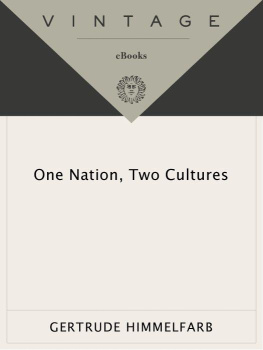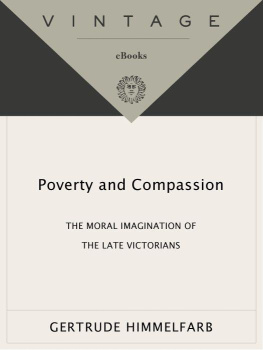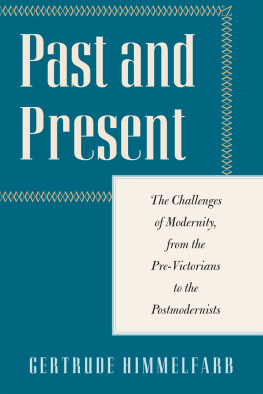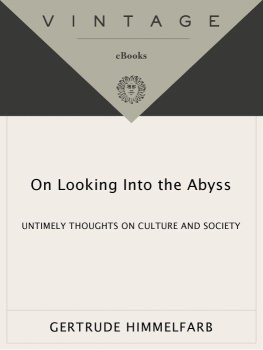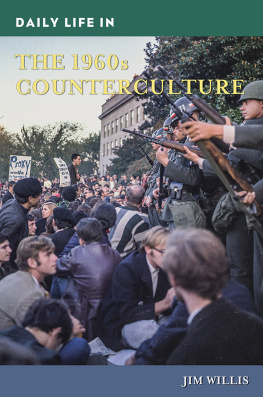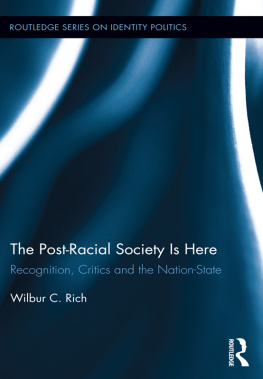ALSO BY GERTRUDE HIMMELFARB
The De-Moralization of Society: From Victorian Virtues to Modern Values (1995)
On Looking into the Abyss: Untimely Thoughts on Culture and Society (1994)
Poverty and Compassion: The Moral Imagination of the Late Victorians (1991)
The New History and the Old (1987)
Marriage and Morals Among the Victorians (1986)
The Idea of Poverty: England in the Early Industrial Age (1984)
On Liberty and Liberalism: The Case of John Stuart Mill (1974)
Victorian Minds (1968)
Darwin and the Darwinian Revolution (1959)
Lord Acton: A Study in Conscience and Politics (1952)
EDITOR OF :
Alexis de Tocqueville, Memoir on Pauperism (1997)
John Stuart Mill, On Liberty (1974)
John Stuart Mill, Essays on Politics and Culture (1962)
T. R. Malthus, On Population (1960)
Lord Acton, Essays on Freedom and Power (1948)
THIS IS A BORZOI BOOK PUBLISHED BY ALFRED A. KNOPF
Copyright 1999 by Gertrude Himmelfarb
All rights reserved under International and Pan-American Copyright Conventions. Published in the United States by Alfred A. Knopf, a division of Random House, Inc., New York, and simultaneously in Canada by Random House of Canada Limited, Toronto. Distributed by Random House, Inc., New York.
www.randomhouse.com
Knopf, Borzoi Books, and the colophon are registered trademarks of Random House, Inc.
are partially based on articles in The Weekly Standard, Sept. 9, 1996; in Commentary, May 1997; and in The Public Interest, Spring 1998.
Library of Congress Cataloging-in-Publication Data
Himmelfarb, Gertrude.
One nation, two cultures / by Gertrude Himmelfarb. 1st ed.
p. cm.
eISBN: 978-0-307-77330-2
1. Culture. 2. Sociology. I. Title
HM101.H49 1999
306dc21 99-18922
v3.1
For Robyn and Charles Krauthammer
CONTENTS
CHAPTER I
A HISTORICAL PROLOGUE: THE VICES OF LEVITY
AND THE DISEASES OF DEMOCRACY
CHAPTER II
CIVIL SOCIETY: THE SEEDBEDS OF VIRTUE
CHAPTER III
THE FAMILY: A MINIATURE SOCIAL SYSTEM
CHAPTER IV
THE LAW AND POLITY: LEGISLATING MORALITY
CHAPTER V
RELIGION: THE FIRST OF THEIR POLITICAL INSTITUTIONS
CHAPTER VI
THE TWO CULTURES: AN ETHICS GAP
EPILOGUE:
SOME MODEST PREDICTIONS
PREFACE
Contemporary history used to be an oxymoron. History was supposed to be set firmly in the past, recollected in tranquillity, with contemporaries safely dead, passions cooled, and documents neatly stored in archives or awaiting discovery in dusty attics. Like the fifty-year rule governing the release of some official records, courses in history departments stopped well short of the last war or two, the last king or two, certainly the last administration or two (or three or four).
Fernand Braudel, not at all traditional in other respectsone of the foremost practitioners of the Annaliste mode of history, which dismisses the ephemera of politics in favor of la longue dure, the deeper realities of geography, demography, and economywrote his monumental work on the Mediterranean in the age of Philip II while confined in a prisoner-of-war camp in Germany during World War II. All those occurrences, he later wrote, which poured in upon us from the radio and the newspapers of our enemies, or even the news from London which our clandestine receivers gave usI had to outdistance, reject, deny them. Down with occurrences, especially vexing ones! I had to believe that history, destiny, was written at a much more profound level.
Those vexing occurrences included the bloody battles that eventually led to the defeat of the Nazis and the revelations of one of the most horrendous episodes in human history, the Holocaust.
Other historians, so far from trying to outdistance, reject, deny the momentous events of their time, have sought instead to record, analyze, and understand them. (And not only the momentous events but, as the latest genre of cultural studies demonstrates, the most trivial and transient ones.) Yet there are lingering traces of doubt and disquiet. Have we forfeited the long view that enables us to put the present in perspective? Are we inclined to overestimate the importance of experiences we have personally had and to dramatize events we may have witnessed? Are we unduly impressed by change (a golden age lost or a new world gained) rather than continuity and permanence? And do we find revolutions in every deviation or aberration?
Revolutions present a special difficulty. Historians are wary of the very word. They are even grudging in applying it to political events (was the English Revolution of 1688 a revolution or merely a restoration?), let alone to social or cultural events. And still more to social or cultural events in their own time. Yet occasionally, very occasionally, they are destined to live through real revolutions. I believe that those of us of an age have lived through such a revolutiona revolution in the manners, morals, and mores of society. This does not mean that it has transformed every realm of life, any more than did other revolutions worthy of the namethe industrial revolution last century or the technological revolution more recently. But it has had a profound effect upon our institutions and relationships, private and public.
It has also bequeathed to us, in this postrevolutionary period, a society fragmented and polarized, not only along the familiar lines of class, race, ethnicity, religion, and gender, but along moral and cultural lines that cut across the others. As the implications and consequences of the revolution work themselves out, people have responded with varying degrees of acquiescence and resistance. In their most extreme form, these differences take on the appearance of a moral divide, a culture war. More often, they express themselves in tensions and dissensions of a lesser order. It is a tribute to the American people and the strength of our traditions and institutions that these disputes have been conducted, for the most part, with civility and sobriety.
Because I myself am leery of the idea of revolution, I have taken special pains to document this one by the hardest kind of evidence, quantified data. Fortunately, one result of this revolution is the availability of just such material. Government agencies and private foundations, research centers in and outside academia, social scientists and pollsters, professional journals, and even the daily newspapers produce a variety of statistics, surveys, analyses, polls, charts, graphs, and tables that are the envy of historians working on more remote periods of the past. I do not, to be sure, subscribe to the dictum, attributed to the British scientist Lord Kelvin, etched over a window in the Social Science building of my alma mater, the University of Chicago: When you cannot measure, your knowledge is meager and unsatisfactory. I believe there are other sources of knowledge that are sometimes more compelling than numbers: philosophy, history, literature, tradition, religion, common sense. I am also wary of quantification when it is represented as the sole or highest form of historical evidence, particularly for periods of the past when it is sparse and highly selective, and when whatever statistics happen to exist are permitted to determine the subjects that the historian deems worthy of attention. But for the study of contemporary affairs, where such information is both plentiful and pertinent, these reservations do not hold. Statistics can be faulty and polls deceptive, and neither should be taken too literally or precisely. But used in conjunction with other kinds of evidence (impressionistic, literary, or theoretical, as quantifiers say disparagingly), they have been invaluable in establishing some hard facts and correcting some common misconceptions.
Next page
